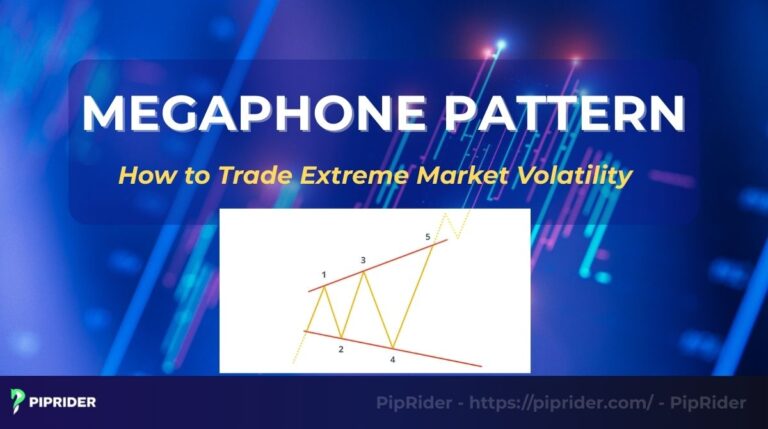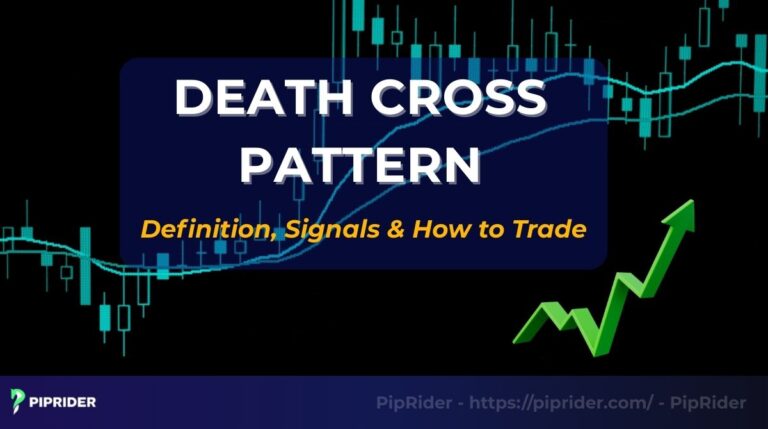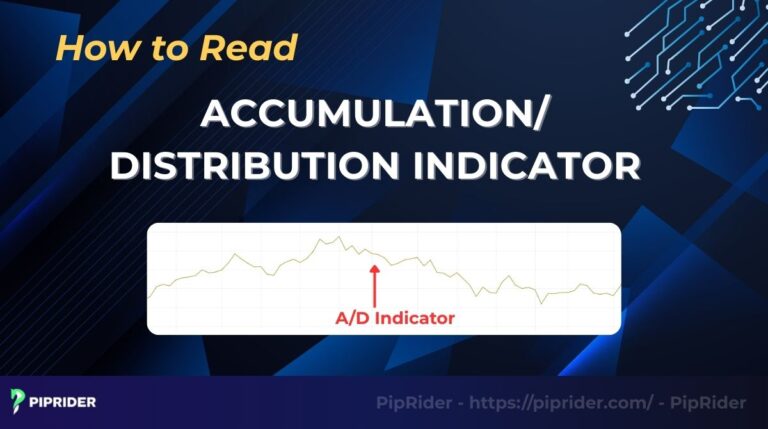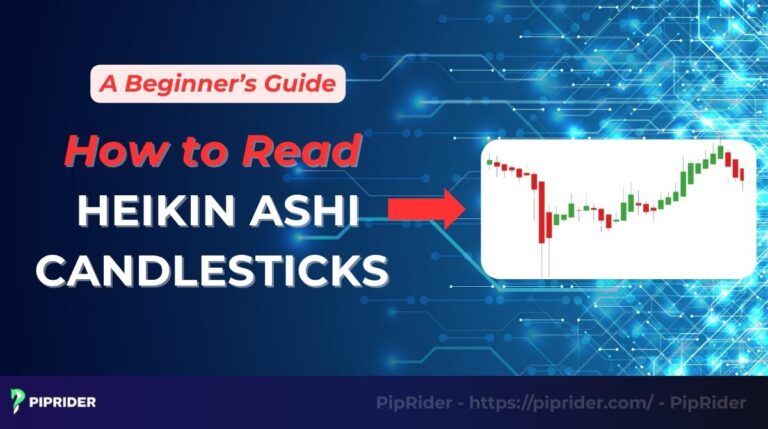Continuation candlestick patterns are definitive signals, not market noise. They provide the highest probability entries because they exploit controlled chart formation within an active trend.
This guide delivers the structural and psychological edge required to master these powerful continuation patterns and confirm valid breakouts. It focuses on strong bullish candlestick patterns and the discipline of patient trading.
Key Takeaways
- A continuation pattern is a controlled, high-probability pause, confirming the dominant trend is merely reloading, not reversing.
- Prioritize multi-candle formations for strong structural confirmation. These are generally considered reliable patterns.
- Use Volume and Momentum Indicators (RSI/MACD) to filter weak patterns and confirm continuation.
- Place Stop Losses (SL) tightly inside the consolidation structure for optimal risk-to-reward.
- Enter only when the definitive confirmation candle close is secured outside the pattern’s range.
1. What Are Continuation Candlestick Patterns?
A continuation pattern is a temporary, low-volatility pause that forms mid-trend. Its purpose is to signal that an existing trend continuation pattern is set to resume, not reverse (Investopedia, 2025).

The core continuation meaning is that the market is pausing to recharge, allowing the dominant force to absorb minor counter-pressure before accelerating. A bullish/bearish continuation pattern simply refers to the pattern resolving in the direction of the prior move.
The pause reflects critical market psychology, confirming the trend’s underlying strength:
- Profit absorption: The pause is triggered by minimal profit-taking or short-term counter-trend attempts being absorbed.
- Liquidity gathering: This period of controlled consolidation patterns allows institutional traders to adjust positions without creating premature volatility.
- Dominance confirmed: The pattern validates that the opposing force is too weak to cause a reversal. The trend is simply “resting” before the next expansion.
Continuation vs. Reversal: Key Differences
Mastering the difference between these two pattern types is crucial; misidentifying one for the other is a common, costly mistake in trading. The table below outlines the core structural and psychological differentiators:
| Feature | Continuation Patterns | Reversal Patterns |
| Signal Intent | Confirms the trend will continue. | Signals the trend is about to change direction. |
| Location | Occurs mid-trend. | Occurs at trend extremes (swing highs/lows). |
| Risk Profile | Statistically higher probability (with the flow). | Statistically lower probability (against the flow). |
2. Key Types of Continuation Candlestick Patterns
Structural analysis is paramount. These key patterns are prioritized because their specific formations, ranging from controlled consolidation chart patterns to immediate negation, provide the highest clarity and certainty for trend continuation entries.
2.1. Rising Three Methods Pattern
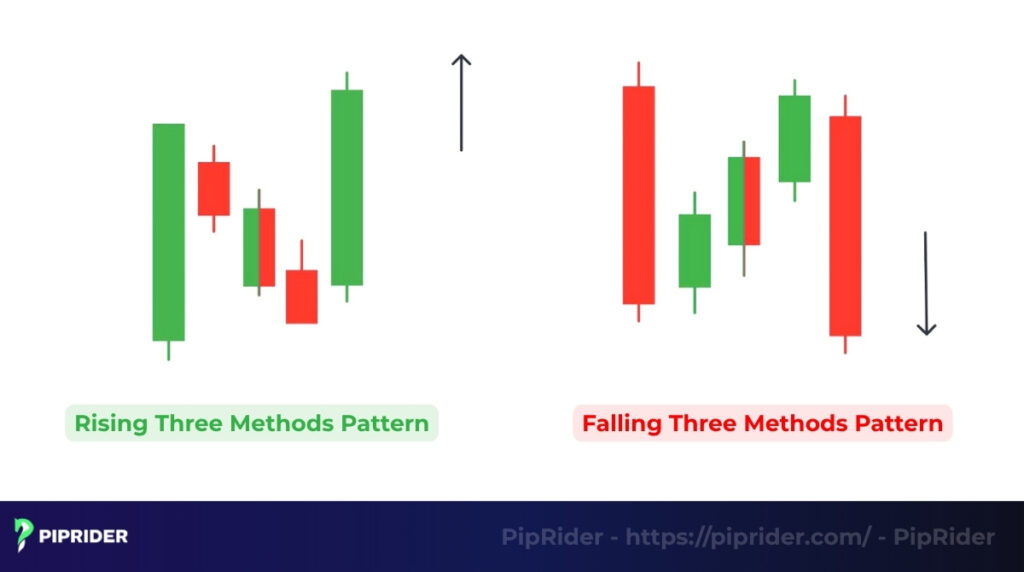
This is the most reliable strong bullish candlestick pattern, signaling a decisive continuation after a controlled pause.
- Structure: The pattern consists of a long bullish candle (C1) followed by three small, contained candles (C2-C4) that must remain entirely within the range of C1. It concludes with a large bullish candle (C5) that closes decisively above C1’s high.
- Meaning: C2-C4 represents weak, controlled profit-taking that is fully absorbed. The powerful C5 close confirms the bulls have neutralized all selling pressure, securing the candlestick continuation.
- Application: Entry is triggered upon the close of C5, with the Stop Loss placed immediately below the low of the C2-C4 range for optimal risk control.
2.2. Separating Lines Pattern
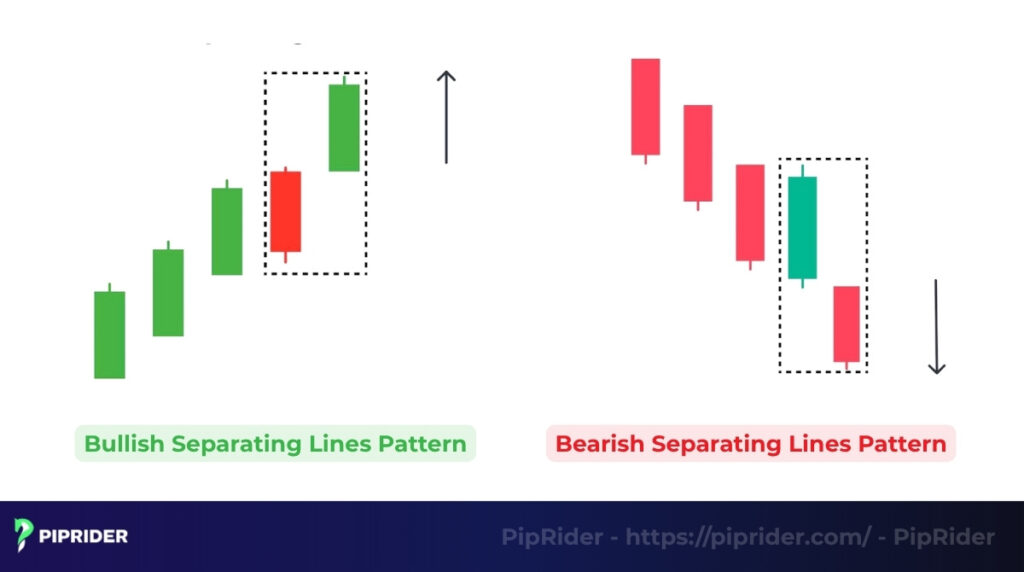
The Separating Lines Pattern is a high-conviction candlestick pattern continuation signal. It confirms the trend is resuming immediately, as the previous counter-trend attempt is violently negated at the opening bell (Bravetotrade, 2021; LuxAlgo, 2025).
- Bullish Separating Lines: In an uptrend, the pattern features a bearish candle (C1) immediately followed by a long bullish candle (C2) that opens at the exact same price as C1’s open. This structure signals the immediate and decisive rejection of selling pressure, securing the upward move.
- Bearish Separating Lines: In a downtrend, the pattern features a bullish candle (C1) followed by a long bearish candle (C2) that opens at the exact same price as C1’s open. This confirms that the attempt by buyers to push the price higher was nullified at the open, guaranteeing sustained bearish control.
- Reliability and practical application: This pattern is highly reliable due to the aggressive negation of the prior candle’s move. It is used for aggressive entries immediately upon C2’s close. Due to the rapid signal, a tight Stop Loss must be placed just beyond C2’s extreme to manage risk efficiently.
2.3. Doji Star Continuation Pattern
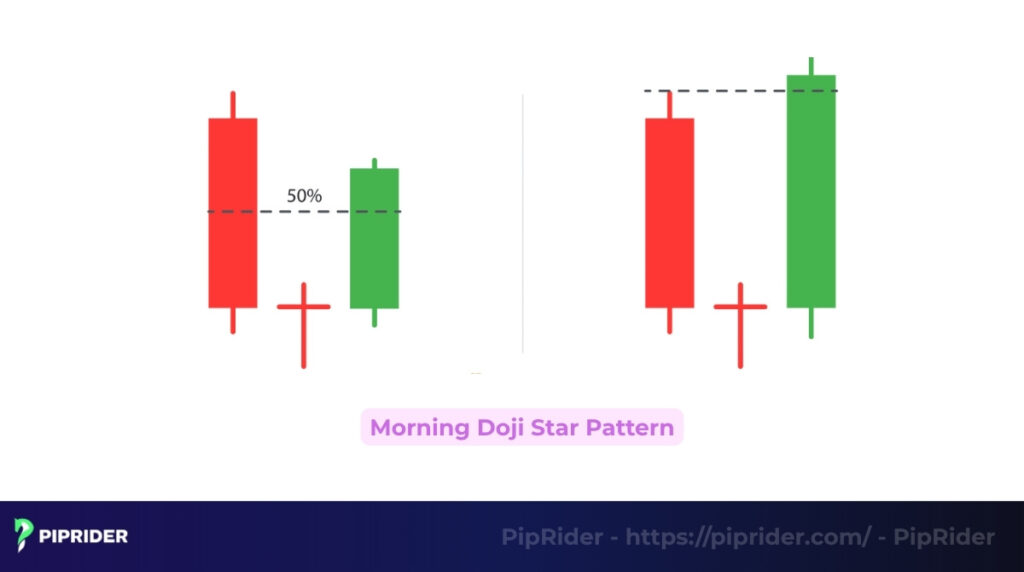
While the Doji typically signals reversal, its appearance mid-trend signals a powerful pause that is quickly overcome.
- Candle structure: A strong trend candle (long body) is followed by a small-bodied candle, a Doji or a very small Spinning Top, that gaps slightly away from the preceding candle’s body.
- When it appears: It occurs mid-trend after a major momentum push, signalling the market is “taking a breath” or experiencing minor exhaustion before the primary trend resumes.
- Trading application: This is a case for patience candle trading. The continuation is confirmed only if the subsequent candle breaks and closes decisively in the direction of the initial direction. Entry is taken after this confirmation candle closes, with the stop loss placed beyond the extreme of the Doji’s range.
Read more:
Hikkake Pattern Explained: Complete Guide for Traders
2.4. Deliberation Pattern

The Deliberation Pattern highlights extreme hesitation before the trend resumes, signaling a temporary deadlock in momentum that is ultimately resolved by the dominant force.
- Description: This pattern involves a long trend candle followed by three consecutive small candles (often same-colored bodies) that show minimal price range progression. These three candles form a tight holding pattern zone near the close of the initial strong candle.
- Strengths and limitations: The pattern’s strength is the clear signal of hesitation being overcome, making the subsequent breakout highly predictable. Its primary limitation is the low-volatility nature, meaning it critically requires a major volume spike on the breakout candle to confirm validity.
- Case study: This setup frequently appears on the daily chart of highly liquid asset prices (e.g., S&P 500 or major FX pairs). For instance, following a strong 3% rally (C1), three days of near-flat trading (C2-C4) signal market “deliberation.” The candlestick continuation is validated only when the price decisively closes above the C1/C4 high on the fifth day, confirming the absorption phase is complete and institutional momentum has resumed.
2.5. Matching High Pattern

The Matching High Pattern (or its inverse, Matching Low) is a simple but effective two-candle formation. This pattern indicates a specific price level was tested twice before the direction ultimately overcame the resistance. It’s a clear signal of minor price consolidation patterns.
- Structural characteristics: This pattern features two consecutive trend candles whose highs (for an uptrend) or lows (for a downtrend) are exactly or nearly equal. This equality identifies a temporary price barrier that the market could not immediately penetrate.
- How to confirm trend continuation: Confirmation is achieved only when the subsequent candle decisively breaks and closes beyond that matched high/low level. This successful breakout confirms that the necessary momentum has been built to overwhelm the temporary resistance and resume the continuation pattern.
- Real-world example: On a daily chart, if the price makes an equal high on Monday and Tuesday (forming the pattern), a trader will wait for a Wednesday close above that exact high. Entry is taken on that confirmed close, with the Stop Loss placed below the lowest point of the two candles (Monday/Tuesday) for efficient risk sizing.
2.6. Other Notable Continuation Patterns
These patterns appear less frequently or require careful contextual reading. For comprehensive analysis, they often serve as precise entry triggers within larger chart patterns like Wedges or Cup and Handles, offering powerful supplementary evidence for trend continuation.
| Pattern | Structure | Significance |
| Advance Block | A three-candle pattern in an uptrend where three long white (bullish) candles follow each other, but each subsequent body is progressively smaller, with long upper shadows. | Signals that bullish momentum is waning slightly due to increasing selling pressure near the high, often preceding one final surge or a necessary, brief pause. |
| Hanging Man (Continuation Form) | A bearish single-candle pattern (small body, long lower wick) appearing mid-uptrend and immediately followed by a large bullish candle. | In this context (mid-trend), the pattern is instantly negated by the next candle, confirming that the brief selling attempt failed and the primary trend remains dominant. |
| Side-by-Side White Lines | Two long white (bullish) candles that share similar body lengths and open with a gap to the upside. | A very strong bullish continuation pattern that demonstrates relentless and sustained buying pressure, leaving little chance for a meaningful pullback. |
| Upside Gap Two Crows | Occurs in an uptrend. A gap up is followed by two consecutive small bearish candles whose bodies stay above the initial gap support. | Signals a minor bearish pause or mild profit-taking within a strong uptrend. Since the sellers fail to close the gap, the underlying trend remains dominant and continuation is expected. |
3. Trading Strategies Using Continuation Patterns
Trading strategies for continuation patterns maximize the high-probability nature of these setups.

3.1. Entry & Exit Rules
Effective trading of continuation candlestick patterns relies on strict execution rules and disciplined risk management (Wright Research, 2025).
- Entry (Breakout Confirmation): Never enter until the confirmation candle closes successfully outside the pattern’s boundary. Execute the trade immediately on the close to capture momentum.
- Exit (Stop Loss & Take Profit): Place the Stop Losses (SL) tightly inside the pattern’s structure for the best Risk:Reward ratio. Set the profit targets using the measured move rule or the next major structural support/resistance (minimum 1:2 R:R).
3.2. Validating with Technical Indicators
Robust external validation is crucial for confirming continuation candlestick patterns and filtering false signals.
- Moving Averages (MAs): Use MAs (e.g., 50/200-period) as a filter. The pattern must form on the correct side of the MA to ensure alignment with the dominant market bias.
- RSI / MACD (Momentum): During consolidation, momentum should be resting (RSI 40-60; MACD contracting). Crucially, abandon the trade if divergence is present, as it signals reversal risk.
- Volume confirmation: Volume is the ultimate validator. It must be low and decreasing during the pattern’s formation but then show a sharp surge in volume on the breakout candle to confirm institutional conviction.
3.3. Multi-Timeframe Analysis for Continuation Patterns
Using multiple timeframes adds a crucial layer of conviction to any continuation candlestick patterns trade.
- Combining timeframes: Use the higher timeframe (e.g., Daily or 4-hour) to establish the dominant continuation pattern direction and identify major support/resistance. The higher timeframe is where you often spot larger chart formations like triangles, flags, pennants, or rectangles. Then, drop to the lower timeframe (e.g., 1-hour or 15-minute) to spot the specific candlestick pattern and determine precise entry/exit points.
- Advantage in filtering false signals: Confirming a pattern on the lower timeframe against a confirmed trend on the higher timeframe significantly reduces the probability of false breakouts. This ensures you are always trading with the prevailing institutional flow, turning low-conviction setups into high-probability continuation patterns.
4. Pros and Cons of Continuation Patterns
Trading continuation candlestick patterns offers clear advantages but requires vigilance regarding specific risks.
- Pros (Advantages): These patterns are generally easy to identify visually as pauses within established trends. Crucially, because the entry point (the breakout) is close to the tight Stop Loss (placed inside the consolidation), they offer a superior Risk-to-Reward (R:R) ratio when successfully trading with the dominant direction. They are highly regarded as reliable patterns.
- Cons (Disadvantages): The primary risk is encountering a false breakout. Without strict Volume confirmation and multi-timeframe alignment, the price can briefly exit the pattern only to reverse back into the trading range, leading to premature stops. Trading without confirmation often leads to relying on weak patterns.
5. Common Mistakes and How to Avoid Them
Avoiding these critical errors is as important as recognizing the continuation patterns themselves. Discipline separates profitable traders from those who suffer repeated losses from false breakouts.
- Confusing continuation with consolidation: Not every period of sideways movement leads to a continuation.
The fix: Only trade the pattern after the price breaks out in the direction of the long-term trend and is validated by Volume and Momentum Indicators. - Entering too early without confirmation: This is the most costly mistake.
The fix: Strict adherence to patient trading. Always wait for the confirmation candle to close outside the pattern’s boundary to avoid immediate false breakouts. - Overtrading with continuation patterns: Seeing these patterns everywhere leads to taking too many low-quality setups.
The fix: Prioritize quality over quantity. Limit trades to patterns confirmed on higher timeframes (H4/Daily) and only when they align with all validation rules (Volume, MA, Momentum).
6. Frequently asked questions about Continuation Candlestick Patterns
7. Conclusion
Continuation candlestick patterns are not signals of market indecision but rather high-probability opportunities where the direction takes a controlled pause before resuming its trajectory.
By prioritizing robust formations like the Rising Three Methods and adhering to confirmed breakouts, traders move beyond simply guessing momentum and execute trades with structural conviction, setting clear profit targets.
The ultimate key to success lies in disciplined execution: always validate your pattern with external indicators (Volume, MAs, Momentum) and rigorously apply risk control by placing a tight Stop Loss inside the consolidation zone. To deepen your expertise in reading market structure and price action, explore Piprider’s other advanced analyses in the Analysis category.



